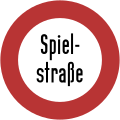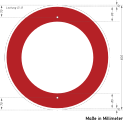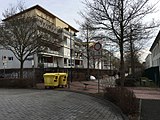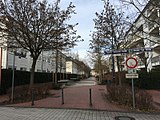Play street
According to the German administrative regulation for the road traffic regulations (VwV-StVO) § 41 Abs. 2 Nr. 6 StVO by the sign 250 a play street is closed for vehicles of all kinds. The additional sign 1010-10 allows children to play on the road and the hard shoulder. Sports can also be permitted with an additional sign. The administrative regulation for sign 250 StVO states: "The unrestricted ban on all traffic justifies the use of the entire street by pedestrians and children playing." Since a blockade of the street by sign 250 also affects residents , this constellation is quite rare. Local governments can also dedicate so-called "temporary play streets" in their area of responsibility. For this purpose, a corresponding street is blocked for vehicle traffic for a specified period of time.
history
As early as the beginning of the 1920s, voices were heard from the medical profession calling for play streets to be built. The main reason for this were austerity measures by the cities, which led to the closure of public playgrounds. For the ophthalmologist Carl Hamburger (1870–1944), who worked in Berlin, the focus was on the health aspect that young people's organism can only benefit from the positive properties of nature by consistently staying outdoors. He suggested building these play streets on the extra-wide, low-traffic arteries of the cities. These streets should be tapered to three to four meters wide, as should the extra-wide sidewalks. The space gained can then be filled with earth and the broken paving stones can be sold. The children could use this space. Hamburger stood up for his convictions for many years. In a lecture he gave in 1929, he stated that his ideas about play streets were picked up in 1925 in New York and only recently in Tokyo . Only in Berlin had he not had any success until then.
The attempts that subsequently took place with play streets in German cities were often short-lived. In many cases, they failed because of the resistance of the residents who felt annoyed by the noise and because of the road users who had to accept traffic restrictions. In 1936, for example, the Stuttgart police chief withdrew his tentative introduction of play streets after just a few months. Even after the Second World War, the legal situation for play streets remained problematic. Following suggestions from the building administration, the education authority and the police, a total of 21 streets in Bochum were declared play streets in a meeting on November 29, 1949. The reason for this was that all children's playgrounds had been destroyed in the war. After complaints from residents, in particular miners on the night shift who had to sleep during the day, but especially due to an accident with a child in which the city was made liable for the treatment costs in the hospital, the city managed - in order to avoid further liability damage - in October 1952 the play streets again. Of the 21 playing streets, 12 were canceled. The official reason given was that at this point in time, space had been created in the vicinity outside of the streets. The additional sign “Spielstraße” was removed from the remaining streets and replaced by a caution sign saying “Playing children”.
In the German Democratic Republic (GDR) a blocking sign with the inscription "Spielstraße" was included in the road traffic regulations from 1956. This step created legal certainty there for the first time . The sign prohibited vehicles of any kind from using the path marked as a play street. Only residents were allowed to pass.
From the end of the 1960s, general traffic prohibition signs with the additional sign “Spielstraße - local traffic free” were introduced in residential streets in West Germany . With the entry into force of the new version of the StVO in 1971, an additional pictorial sign with the meaning "Children may play on the road and the hard shoulder" became valid for the first time. In accordance with the legal requirements in the StVO, it was set up with the general traffic ban sign 250. In the GDR signs with the inscription "Spielstraße" have not been used since 1979. In May 1979 the new standard TGL 12096/01 came into effect there. Now, as in West Germany, a symbol as an additional sign regulated the area of the Spielstraße.
The catchy term “Spielstraße” remained in use because the traffic-calmed area was not introduced into the road traffic regulations of the Federal Republic of Germany until 1980. In the GDR, the term "Spielstraße" was retained until the turn of the year 1990 through the StVO which became valid in 1978 . From 2000 the use of the term received a new impetus due to the discussions about shared space and the meeting zone.
- Excerpt from the picture panels of the traffic signs of the GDR
Fig. 201
Traffic ban for all vehicles ( illustration from 1979 to 1990 )
- Excerpt from the picture panels of the traffic signs of the Federal Republic of Germany
Additional sign in the Federal Republic of Germany, late 1960s ( see picture ).
Signage combination with the sign 250 became legally valid in West Germany in 1971 .
Current version of the signage since 1992 : Allows children to play on the street. The symbol is a decoupling from the symbol 325, which was introduced in the Federal Republic of Germany in 1980.
- Sample images of play streets
This play street is cordoned off with bollards .
Game road on time
Local governments can introduce play streets temporarily in their area of responsibility. For this purpose, a corresponding street is blocked for vehicle traffic for a specified period of time. One of the first municipalities to realize this was the Hessian city of Griesheim in 2002 .
In August 2019 was the Berlin district of Kreuzberg , the Boeckhstrasse as temporary road game free. It is completely closed to motor vehicle traffic every Wednesday between 2 p.m. and 6 p.m. In addition to the usual traffic signs, large-scale blue markings in the middle of the street, which represent the game street sign with white color, are used for identification.
During the Rhineland-Palatinate summer vacation, the city of Bad Kreuznach will close three streets from July 13th to August 14th, 2020 in order to make them temporary play streets.
See also
such as
literature
- Carl Hamburger: Playroom for big city children. Proposals for a better use of urban open spaces . Teubner, Berlin / Leipzig 1919
- Wolf Jobst Siedler : Ordained cosiness: Swan song on play street, traffic calming and maintenance of the cityscape. Severin, Berlin 1985, ISBN 3-88679-125-4 .
Web links
- Stimulate play streets on time. Enable. Simplify. from the campaign “More space for children. A win for everyone! ”An initiative of the Road Safety Working Group at the Ministry of Building, Housing, Urban Development and Transport of the State of North Rhine-Westphalia.
Individual evidence
- ^ Carl Hamburger: Spielstraßen or the shortest way to get outdoors . In: German quarterly journal for public health care , issue 11 (1921), pp. 388-390; here: pp. 388–389.
- ^ Lecture by Carl Hamburger. In: Journal for School Health Care and Social Hygiene (1929), p. 48 u. P. 50.
- ^ Municipal mosaic . In: The parish day. Journal for German Community Policy, Volume 30, No. 7 (1936), p. 303.
- ^ Administrative report of the city of Bochum , 1952, p. 71.
- ↑ Rolf Jedicke: Ordinance on behavior in road traffic - Road Traffic Regulations (StVO) - from October 4, 1956. In: Der deutsche Straßenverkehr. Special issue, November 1956 (without page numbers)
- ↑ Bundesgesetzblatt, Volume 1970, No. 108, date of issue: Bonn, December 5, 1970. p. 1588.
- ↑ Use of the term “ Spielstraße ” in the Google Ngram Viewer from 1960 to 2008.
- ^ Berlin's first temporary play street in Kreuzberg . In: Berliner Morgenpost , August 7, 2019.
- ↑ Several streets in Bad Kreuznach become temporary play streets - request for Tempo 30 in the city area bad-kreuznach.de; online on the Internet: July 12, 2020








